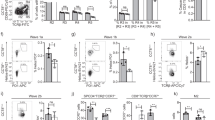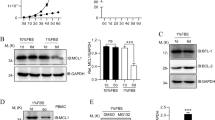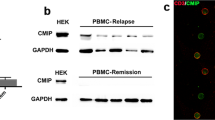Abstract
T cell homeostasis is essential for the functioning of the vertebrate immune system, but the intracellular signals required for T cell homeostasis are largely unknown. We here report that the WD-repeat protein family member coronin-1, encoded by the gene Coro1a, is essential in the mouse for T cell survival through its promotion of Ca2+ mobilization from intracellular stores. Upon T cell receptor triggering, coronin-1 was essential for the generation of inositol-1,4,5-trisphosphate from phosphatidylinositol-4,5-bisphosphate. The absence of coronin-1, although it did not affect T cell development, resulted in a profound defect in Ca2+ mobilization, interleukin-2 production, T cell proliferation and T cell survival. We conclude that coronin-1, through activation of Ca2+ release from intracellular stores, is an essential regulator of peripheral lymphocyte survival.
This is a preview of subscription content, access via your institution
Access options
Subscribe to this journal
Receive 12 print issues and online access
$209.00 per year
only $17.42 per issue
Buy this article
- Purchase on Springer Link
- Instant access to full article PDF
Prices may be subject to local taxes which are calculated during checkout







Similar content being viewed by others
References
Starr, T.K., Jameson, S.C. & Hogquist, K.A. Positive and negative selection of T cells. Annu. Rev. Immunol. 21, 139–176 (2003).
Sprent, J. & Tough, D.F. T cell death and memory. Science 293, 245–248 (2001).
Goldrath, A.W. & Bevan, M.J. Selecting and maintaining a diverse T-cell repertoire. Nature 402, 255–262 (1999).
Jameson, S.C. Maintaining the norm: T-cell homeostasis. Nat. Rev. Immunol. 2, 547–556 (2002).
Takeda, S., Rodewald, H.R., Arakawa, H., Bluethmann, H. & Shimizu, T. MHC class II molecules are not required for survival of newly generated CD4+ T cells, but affect their long-term life span. Immunity 5, 217–228 (1996).
Kirberg, J., Berns, A. & von Boehmer, H. Peripheral T cell survival requires continual ligation of the T cell receptor to major histocompatibility complex-encoded molecules. J. Exp. Med. 186, 1269–1275 (1997).
Polic, B., Kunkel, D., Scheffold, A. & Rajewsky, K. How alpha beta T cells deal with induced TCR alpha ablation. Proc. Natl. Acad. Sci. USA 98, 8744–8749 (2001).
Labrecque, N. et al. How much TCR does a T cell need? Immunity 15, 71–82 (2001).
Gatfield, J., Albrecht, I., Zanolari, B., Steinmetz, M.O. & Pieters, J. Association of the leukocyte plasma membrane with the actin cytoskeleton through coiled coil-mediated trimeric coronin 1 molecules. Mol. Biol. Cell 16, 2786–2798 (2005).
Foger, N., Rangell, L., Danilenko, D.M. & Chan, A.C. Requirement for coronin 1 in T lymphocyte trafficking and cellular homeostasis. Science 313, 839–842 (2006).
Jayachandran, R. et al. Survival of mycobacteria in macrophages is mediated by coronin 1-dependent activation of calcineurin. Cell 130, 37–50 (2007).
Jayachandran, J. et al. RNA interference in J774 macrophages reveals a role for coronin 1 in mycobacterial trafficking but not in actin-dependent processes. Mol. Biol. Cell (in the press).
Gallo, E.M., Cante-Barrett, K. & Crabtree, G.R. Lymphocyte calcium signaling from membrane to nucleus. Nat. Immunol. 7, 25–32 (2006).
Lewis, R.S. Calcium signaling mechanisms in T lymphocytes. Annu. Rev. Immunol. 19, 497–521 (2001).
Zhang, W., Wu, Y., Du, L., Tang, D.D. & Gunst, S.J. Activation of the Arp2/3 complex by N-WASp is required for actin polymerization and contraction in smooth muscle. Am. J. Physiol. Cell Physiol. 288, C1145–C1160 (2005).
Bunnell, S.C., Kapoor, V., Trible, R.P., Zhang, W. & Samelson, L.E. Dynamic actin polymerization drives T cell receptor-induced spreading: a role for the signal transduction adaptor LAT. Immunity 14, 315–329 (2001).
Nolz, J.C. et al. The WAVE2 complex regulates actin cytoskeletal reorganization and CRAC-mediated calcium entry during T cell activation. Curr. Biol. 16, 24–34 (2006).
Murali-Krishna, K. et al. Persistence of memory CD8 T cells in MHC class I-deficient mice. Science 286, 1377–1381 (1999).
Swain, S.L. CD4 T-cell memory can persist in the absence of class II. Phil. Trans. R. Soc. Lond. B 355, 407–411 (2000).
Huang, Y. & Wange, R.L. T cell receptor signaling: beyond complex complexes. J. Biol. Chem. 279, 28827–28830 (2004).
Zhang, W., Sloan-Lancaster, J., Kitchen, J., Trible, R.P. & Samelson, L.E. LAT: the ZAP-70 tyrosine kinase substrate that links T cell receptor to cellular activation. Cell 92, 83–92 (1998).
Altman, A. & Villalba, M. Protein kinase C-theta (PKCθ): it's all about location, location, location. Immunol. Rev. 192, 53–63 (2003).
Thastrup, O., Cullen, P.J., Drobak, B.K., Hanley, M.R. & Dawson, A.P. Thapsigargin, a tumor promoter, discharges intracellular Ca2+ stores by specific inhibition of the endoplasmic reticulum Ca2+-ATPase. Proc. Natl. Acad. Sci. USA 87, 2466–2470 (1990).
Nal, B. et al. Coronin-1 expression in T lymphocytes: insights into protein function during T cell development and activation. Int. Immunol. 16, 231–240 (2004).
Nakayama, T. et al. Inhibition of T cell receptor expression and function in immature CD4+CD8+ cells by CD4. Science 249, 1558–1561 (1990).
Okumura, M., Kung, C., Wong, S., Rodgers, M. & Thomas, M.L. Definition of family of coronin-related proteins conserved between humans and mice: close genetic linkage between coronin-2 and CD45-associated protein. DNA Cell Biol. 17, 779–787 (1998).
Marrack, P. & Kappler, J. Control of T cell viability. Annu. Rev. Immunol. 22, 765–787 (2004).
Farber, D.L. Differential TCR signaling and the generation of memory T cells. J. Immunol. 160, 535–539 (1998).
Farber, D.L., Acuto, O. & Bottomly, K. Differential T cell receptor-mediated signaling in naive and memory CD4 T cells. Eur. J. Immunol. 27, 2094–2101 (1997).
Roederer, M. et al. Heterogeneous calcium flux in peripheral T cell subsets revealed by five-color flow cytometry using log-ratio circuitry. Cytometry 21, 187–196 (1995).
Denys, A., Aires, V., Hichami, A. & Khan, N.A. Thapsigargin-stimulated MAP kinase phosphorylation via CRAC channels and PLD activation: inhibitory action of docosahexaenoic acid. FEBS Lett. 564, 177–182 (2004).
Ebinu, J.O. et al. RasGRP links T-cell receptor signaling to Ras. Blood 95, 3199–3203 (2000).
Bae, Y.S. et al. Identification of a compound that directly stimulates phospholipase C activity. Mol. Pharmacol. 63, 1043–1050 (2003).
Tulp, A., Verwoerd, D., Dobberstein, B., Ploegh, H.L. & Pieters, J. Isolation and characterization of the intracellular MHC class II compartment. Nature 369, 120–126 (1994).
Gatfield, J. & Pieters, J. Essential role for cholesterol in entry of mycobacteria into macrophages. Science 288, 1647–1650 (2000).
Lee, W.T., Cole-Calkins, J. & Street, N.E. Memory T cell development in the absence of specific antigen priming. J. Immunol. 157, 5300–5307 (1996).
Saparov, A. et al. Memory/effector T cells in TCR transgenic mice develop via recognition of enteric antigens by a second, endogenous TCR. Int. Immunol. 11, 1253–1264 (1999).
Ferrari, G., Langen, H., Naito, M. & Pieters, J. A coat protein on phagosomes involved in the intracellular survival of mycobacteria. Cell 97, 435–447 (1999).
Pieters, J. Evasion of host cell defense mechanisms by pathogenic bacteria. Curr. Opin. Immunol. 13, 37–44 (2001).
Suzuki, K. et al. Molecular cloning of a novel actin-binding protein, p57, with a WD repeat and a leucine zipper motif. FEBS Lett. 364, 283–288 (1995).
Yang, L.J., Rhee, S.G. & Williamson, J.R. Epidermal growth factor-induced activation and translocation of phospholipase C-gamma 1 to the cytoskeleton in rat hepatocytes. J. Biol. Chem. 269, 7156–7162 (1994).
Singer, W.D., Brown, H.A. & Sternweis, P.C. Regulation of eukaryotic phosphatidylinositol-specific phospholipase C and phospholipase D. Annu. Rev. Biochem. 66, 475–509 (1997).
Pieters, J., Horstmann, H., Bakke, O., Griffiths, G. & Lipp, J. Intracellular transport and localization of major histocompatibility complex class II molecules and associated invariant chain. J. Cell Biol. 115, 1213–1223 (1991).
Barda-Saad, M. et al. Dynamic molecular interactions linking the T cell antigen receptor to the actin cytoskeleton. Nat. Immunol. 6, 80–89 (2005).
Teixeiro, E. et al. T cell division and death are segregated by mutation of TCRβ chain constant domains. Immunity 21, 515–526 (2004).
Acknowledgements
We thank L. Kuhn for assistance with two-dimensional SDS-PAGE and J. Kirberg, K. Huygen, H. Korf, V. Jaeggin, E. Teixeiro, M. Daniels, E. Palmer and P. Demougin for help and discussions. Supported by the German Research Council (SFB 497-B5 to H.-R.R.) and the Kanton Basel-Stadt as well as the Swiss National Science Foundation (to J.P.).
Author information
Authors and Affiliations
Contributions
P.M. performed the experiments unless stated otherwise; J.M. generated the coronin-1–deficient mice and performed their phenotypic analysis (shown in Supplementary Figs. 1, 2, 3 and Fig. 2a) with contributions from I.A., B.C., C.B., R.C., H.-R.R. and A.G.R.; J.G. generated the siRNA used in Jurkat T cells and R.J. performed the video microscopy, m-3M3FBS experiments and PtdIns(4,5)P2 analysis as well as the experiments presented in Figures 1b and 3g; R.J. and B.C. together with P.M. performed the experiments shown in Supplementary Figure 6; J.P. coordinated as well as supervised the project and prepared the manuscript.
Corresponding author
Supplementary information
Supplementary Text and Figures
Supplementary Methods, Supplementary Figures 1–8, Supplementary Table 1 (PDF 2295 kb)
Supplementary Video 1
Normal cell spreading of wild-type T cells seeded on polylysine coated slides (control); time-lapse images were acquired every 10 seconds for 30 minutes. (MOV 929 kb)
Supplementary Video 2
Normal cell spreading of Coronin-1-deficient T cells seeded on polylysine coated slides (control); time-lapse images were acquired every 10 seconds for 30 minutes. (MOV 909 kb)
Supplementary Video 3
Normal TCR-mediated cell spreading of wild-type T cells seeded on anti-CD3 + anti-CD28 coated slides; time-lapse images were acquired every 10 seconds for 30 minutes. (MOV 2048 kb)
Supplementary Video 4
Normal TCR-mediated cell spreading of Coronin-1-deficient T cells seeded on anti-CD3 + anti-CD28 coated slides; time-lapse images were acquired every 10 seconds for 30 minutes. (MOV 1903 kb)
Rights and permissions
About this article
Cite this article
Mueller, P., Massner, J., Jayachandran, R. et al. Regulation of T cell survival through coronin-1–mediated generation of inositol-1,4,5-trisphosphate and calcium mobilization after T cell receptor triggering. Nat Immunol 9, 424–431 (2008). https://doi.org/10.1038/ni1570
Received:
Accepted:
Published:
Issue Date:
DOI: https://doi.org/10.1038/ni1570
This article is cited by
-
Wip1 inhibits neutrophil extracellular traps to promote abscess formation in mice by directly dephosphorylating Coronin-1a
Cellular & Molecular Immunology (2023)
-
Activation and regulation of alloreactive T cell immunity in solid organ transplantation
Nature Reviews Nephrology (2022)
-
Possible association of 16p11.2 copy number variation with altered lymphocyte and neutrophil counts
npj Genomic Medicine (2022)
-
Proteomic analysis in lupus mice identifies Coronin-1A as a potential biomarker for lupus nephritis
Arthritis Research & Therapy (2020)
-
Macrophage-microbe interaction: lessons learned from the pathogen Mycobacterium tuberculosis
Seminars in Immunopathology (2018)



